 Carl Purpus, Plant
Collector in Western America
Carl Purpus, Plant
Collector in Western America 
C. A. Purpus Translated from German by
Barbara Ertter
 




|
Bericht des Herrn C. A. Purpus uber seine Tour in das Wuslengebeit des sudlichen und mittleren Nevada, nordluchen Arizona und westlichen Utah. Mitteilungen der Deutschen Dendrologischen Geselischaft Nr. 7. 1898
|  Spring in Ash
Meadows, Nevada. Spring in Ash
Meadows, Nevada.  Devil's Hole,
Ash Meadows, Nevada. Devil's Hole,
Ash Meadows, Nevada. Locations: Ash Meadows. Devils Hole.
We camped one night in the desert and arrived at Ash Meadows toward evening of the next day. This remarkable meadowy valley is another oasis in the desert, distinctive in its hundreds of strongly welling warm springs. These springs form funnel-shaped holes whose depth varies from 12 to 40 feet deep. One of them, "Devil's Hole," is supposed to be immeasurably deep. The holes are filled with clear warm water from 80 to 100 degrees Fahrenheit, populated with small fish scarcely a finger-length long. The streams that flow from the holes all seep into the sand after an abbreviated existence.
|
|  Pahrump, Nevada.
Pahrump, Nevada.  Pahrump, Nevada, with Spring Mountains in the background.
Pahrump, Nevada, with Spring Mountains in the background.
Locations: Charleston Mountains. Pahrump Valley.
We rested here for two days and then departed to Pahrump Valley. On the way there I discovered a new suffruticose Haplopappus or Aster, not yet positively identified. Pahrump lies at the base of the Charleston Mountains, the highest point of which is Charleston Peak, around 11,000’ tall and normally covered with snow to the middle of June. The valley was beautiful although rather rocky and covered with Chenopodiaceae. Prosopis juliflora and Prosopis pubescens, both of which form trees here, grew in the vicinity of the springs. On the cliffs I found Mortonia scabrella A. Gray, a singularly interesting Celastraceae. Gushing springs are also here, hence the Indian (Pah-Ute) name "Pahrum," that is, "water-mountain." The springs water several ranches and then disappear into the sand, as do most desert streams, all of which trickle into the ground after only a short duration. The Amargosa "River" is not really a river, but instead only one such dry stream bed that winds its way down to Death Valley.
|
| 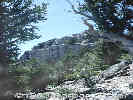 Outcrop in Spring Mountains, Nevada.
Outcrop in Spring Mountains, Nevada. 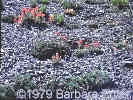 Flowers on limestone ridge, Lee Canyon, Spring Mountains, Nevada.
Flowers on limestone ridge, Lee Canyon, Spring Mountains, Nevada.
Locations: Charleston Mountains. On the following day I decided to
undertake an exploration of the intriguing Charleston Mountains, departing rather early because of the heat. The slopes were at first covered with Larrea mexicana Moric.; Yucca brevifolia Engelm. and Yucca baccata Torr. appeared at 4000 feet. In the so-called washes were Prunus fasciculata A. Gray, Purshia glandulosa [P. tridentata var. g.] Curran, Salazaria mexicana Torr., and Lycium. Among these shrubs grew the splendid Mammillaria deserti Engelm. I encountered the lovely Cowania mexicana D. Don above 4000’ in association with Fallugia paradoxa Endl., which was decorated with both flowers and feather-tailed fruits, as well as the white-flowered Eriodictyon angustifolium Nutt. At a higher elevation I found shrubs of Cowania mexicana that were in full bloom, being covered with large, showy, fragrant, ochroleucous flowers. Fallugia paradoxa was likewise in bloom and covered with gorgeous white flowers. The Cowania ascended to the Quercus gambelii Nutt. zone. In the underbrush blazed the scarlet-flowered Penstemon eatonii A. Gray, one of the most beautiful penstemons I know. In addition I noted Penstemon palmeri A. Gray, Audibertia sp. [Salvia dorrii], and Rhus trilobata Nutt. On the cliffs grew the charming Spiraea [Petrophytum] caespitosa Nutt., a marvelous mat-forming species, and Buddleja utahensis with its sulfur-yellow flowers and white tomentose leaves.
|
| 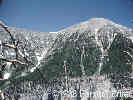 Charleston Peak, Spring Mountains, Nevada.
Charleston Peak, Spring Mountains, Nevada.
Locations: Charleston Peak. We settled down for a
several days’ sojourn at one of the half-dried springs [perhaps in Wheeler Wash?]. The next day I undertook an ascent of Charleston Peak‚ but did not reach the peak as it was too far from our camp. I encountered a moderately thick forest, first composed primarily of scrub oak and two Cercocarpus species, followed by Pinus monophylla and Juniperus occidentalis Hook. var. monosperma. Pinus ponderosa Dougl. var. scopulorum appeared around 6000 to 7000 feet, then Abies concolor Lindl. & Gord., and finally Pinus flexilis James and Pinus aristata Engelm. from 8000 feet on up. The latter ascended to 10,000’ and is the dominant tree of these alpine regions. I also found the lovely Juniperus californicus Carr. var. utahensis, previously mentioned in the desert region. The shrubs that I saw included Philadelphus microphyllus A. Gray, Jamesia americana Torr. & Gray, Spiraea [Holodiscus] dumosa Nutt., Audibertia sp. [Salvia dorrii], and the splendid suffruticose Oenothera hartwegii Benth. In the ravines grew Populus tremuloides Mich. On the return trip I encountered the beautiful Opuntia palmeri, which up to now had been known only from Utah and adjacent Arizona.
|
| On another
exploration I found a mat-forming Oenothera, which has been described by Mrs. Brandegee as a new species named Oenothera saxosa Brandeg., as well as an unidentified shrub close to Fendlera rupicola. I also encountered several times Cercocarpus intricatus S. Wats., which ascended to 8000'.
|
|  Indian Springs, Nevada.
Indian Springs, Nevada.  Indian Springs, Nevada.
Indian Springs, Nevada. Locations: Indian Spring Valley. After we had tarried for two more
days, I decided to continue with our journey. We set out on a beautiful June morning and transferred our camp to Indian Spring Valley‚ on the east [actually northeast] base of the Charleston Mountains. This is a desert valley that is bordered on the east by the steep Desert Range, furrowed with deep valleys, and the Sheep Mountains [apparently "Indian Spring Valley" is used in an expanded sense to include the north end of the Las Vegas Valley]. A spring transforms the center of the valley into a little oasis occupied by a small ranch. I stayed here for two days in order to explore the eastern slopes of the Charleston Mountains. I found Echinocactus wislizeni Engelm., E. lecontei Engelm., E. polycephalus Engelm. & Bigel., Opuntia tesselata Engelm., and others.
|
|  Corn Creek, Sheep Range, Nevada.
Corn Creek, Sheep Range, Nevada.
Locations: Corn Creek. Sheep Range.
Toward the end of June, we left the shady ranch and traveled under scorching sun southward to Lore Creek [probably Corn Creek] at the foot of the Sheep Range, where we made camp for two days. This allowed me to investigate the Sheep Mountains east of camp. The next morning I left the campsite and, after a two-hours’ march through a stony desert, found myself at the entrance to one of the remarkable canyons [probably (?) at the south end of the range] that characterize this mountain. The ravine extended deeply into the mountains, becoming very narrow and dividing into several branches. These were often completely impassable, mainly on account of unscalable rock walls blocking the way. Here I encountered Agave utahensis Engelm. for the first time, with its luminescent yellow flower stalk lifted up above the dark vegetation. In the dry streambed grew Chilopsis saligna D. Don., which from a distance looked like a willow. I also found here a small mat-forming subshrub belonging to Glossopetalon, a shrubby Eriogonum, and a new suffruticose Penstemon that has been named P. petiolatus by Mrs. Brandegee. The entire mountain is botanically very interesting, but very inaccessible because of the shortage of water. Around the campsite grew Acacia greggii A. Gray, armed with sharp curved thorns. I encountered this species more frequently to the south.
|
|  Las Vegas, Nevada.
Las Vegas, Nevada. 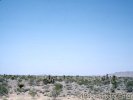 Desert near Las Vegas, Nevada.
Desert near Las Vegas, Nevada.
Locations: Las Vegas. Muddy Creek.
From here we traveled to Las Vegas‚ on one of the next days, a rather level valley surrounded by mountains and rich in springs. From here we continued through the very dry Vegas desert, which is over 50 miles long, to Muddy Creek, which flows through a fertile valley partly covered with grassy flats. Below St. Thomas in southern Nevada it merges with the Virgin River. Both species of Prosopis were very commmon here, especially along the willow and poplar-lined streams. On the slopes grew the usual desert shrubs, primarily Larrea mexicana.
|
| Locations: Saint Thomas. Virgin River. On the next day we proceeded
southeast to St. Thomas, a broad, fertile, but very hot valley, through which Muddy Creek flows. After a short stay here, we continued up the Virgin River, whose muddy red waters flowed swiftly in its broad bed bordered by high banks or bluffs. Prosopis pubescens forms small stands and thickets here, but only along the river.
|
| 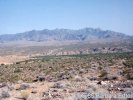 Virgin Range and river valley near Bunkerville, Nevada.
Virgin Range and river valley near Bunkerville, Nevada.
Locations: Bunkerville. Virgin Range.
Above Bunkerville, at the foot of the steep Virgin Range, we stopped for a day in order to explore the mountain range, which extends from northern Arizona into Utah. Steep peaks ascended to 7-8000', forested with Pinus monophylla and Juniperus californicus Carr. var. utahensis. Scrub oak spread out in many places, intermixed with two species of Arctostaphylos. I found a variety of shrubs, several unknown to me, including an interesting silver-leaved Labiatae, Haplopappus, and Ptelea, as well as Fendlera rupicola A. Gray, Fraxinus anomala Torr., Opuntia palmeri, Echinocactus wislizeni, Echinocactus lecontei, and Agave utahensis. I also encountered Eriodictyon angustifolium again, but only near half-dried creeks. Yucca baccata grew in abundance here, covering the rocky slopes of the mountains as high as the Pinus monophylla zone.
|
|  Beaverdam Wash, near Littlefield, Arizona.
Beaverdam Wash, near Littlefield, Arizona.
Locations: Beaverdam. On the following day we continued
up the river, which we had to cross twenty or thirty times, through the northern portion of Arizona to Beaverdam at the foot of the Beaverdam Mountains‚ in Utah. On the steep rocky bluffs of the river occurred 3-4’ high specimens of Echinocactus wislizeni and E. lecontei. Around noon we arrived at Beaverdam, at the confluence of Beaverdam Creek and the Virgin River, and remained here until the following morning. Masses of Vitis arizonica grew on the banks of the river.
|
| On the next day our
route led gradually uphill over the Beaverdam Mountains on the way to St. George in Utah. The slopes of the mountain were covered with Yucca macrocarpa Engelm. and Y. baccata, between which occurred Larrea and the usual desert shrubs. The magnificent Echinocactus johnsoni Parry appeared at about 4-5000’ and was encountered more frequently the higher we went.
|
| 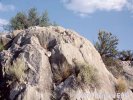 Vegetation at Castle Cliff, Beaverdam Mountains, Utah.
Vegetation at Castle Cliff, Beaverdam Mountains, Utah.
 St. George, Utah.
St. George, Utah. Locations: Castle Cliff. Santa Clara Valley. Saint George.
Towards evening we reached an old campsite at the base of steep cliffs [possibly Castle Cliff?] on which grew Buddleja utahensis, splendid specimens of Echinocactus johnsoni, Echinocactus lecontei, and Agave utahensis. The thin afforestation consisted of the conifers already discussed in greater detail. The following day I encountered the beautiful Berberis fremontii Torr. enroute to the Santa Clara Valley. We reached the summit of the pass before noon and were granted a marvelous view of the vividly red, wonderfully shaped mountain north of St. George. We arrived at St. George, our destination, on the next day. After a two-day rest, we prepared ourselves for the return trip through southwest Utah and central Nevada.
|
|  "For Sale" sign in Diamond Valley, Utah.
"For Sale" sign in Diamond Valley, Utah.  Crater2 at Diamond Valley, Utah.
Crater2 at Diamond Valley, Utah.  Basalt, sage and juniper north of Diamond Valley, Utah.
Basalt, sage and juniper north of Diamond Valley, Utah.
Locations: Diamond Valley. Pine Valley Mountains.
Because of the intense heat, we stayed only a short time in the romantic Mormon town of St. George, remote from the rest of the world. We made our way on rocky routes under the blazing heat of the sun north to Diamond Valley, a fairly well-watered valley lying at the base of the Pine Valley Mountains, a very interesting, steep, jagged mountain range. We did not reach the valley until the following noon, and camped on a plateau in the vicinity of wonderful reddish rock formations dissected by deep canyons. There was a very interesting extinct crater here that appeared to be of recent origin. I explored the crater the next day and found it to be very regularly shaped, with a funnel-shaped mouth some 50-60’ deep surrounded by regular walls. A person sinks to the ankles in volcanic ash and cinders, so the ascent was rather laborious. On the cliffs I found a variety of shrubby Haplopappus and Chrysocoma, as well as Berberis fremontii, Agave utahensis, Opuntia palmeri, and others.
|
| Locations: Pine Mountain. On
the following day I made an ascent of Pine Mountain [Signal Peak?], which reaches a height of 10,000', rising about 2000’ above the wall-like jagged mountain range to the north. Thin forests of Juniperus californicus Carr. var. utahensis and Pinus monophylla covered the base of the mountain. In the canyon I traveled through, I found Robina neomexicana A. Gray, Vitis arizonica, and Rhus glabra L. at 5-6000', as well as Cowania mexicana, which made a splendid sight covered as it was with its feathery tailed fruit. At 7000’ appeared scrub oak thickets forms of Quercus gambeli intermixed with Acer grandidentatum Nutt., between which occurred individuals or groups of Abies concolor Lindl. & Gord. and Pseudotsuga douglasii Carr. At higher altitudes, Cercocarpus ledifolius Nutt. and Populus tremuloides also appeared. The clearings were filled with a magnificent display of splendid blue-flowered Penstemon, red Castilleja, and white Calochortus, with enchanting hummingbirds everywhere. Towards noon I reached the peak, a steep rocky crest with a magnificent view. The conifers attaining the highest altitude were Pinus flexilis James, Abies subalpina Engelm., and Picea engelmanni Engelm., which formed forests even on the highest peaks.
| |
[Previous Page] [Next Page] | |
| [Published Biographies] [Travelogues and Articles] [Letters] [Plant Lists and Bibliography] [Site Administration] | | Date and time this article was prepared: 6/7/2002 7:32:16 PM |